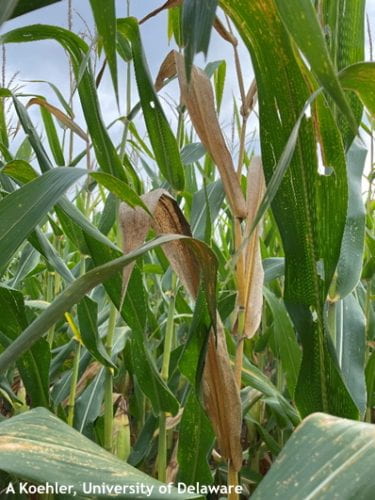Alyssa Koehler, Extension Field Crops Pathologist; akoehler@udel.edu

Figure 1. Corn stalk with accelerated plant senescence
Over the past week, I have begun to see plants with accelerated senescence due to stalk rots (Figure 1). After pollination, the ear becomes the major sink of sugars produced by the plant. If a stress event occurs, plants will divert or remobilize sugars from the stalk and roots to meet the needs of the developing ear. Often the pathogens that cause stalk rots are opportunistic and take advantage of plants that have been weakened by potential stress events (drought, flooding, hail, insect damage, foliar disease damage, etc.).
We typically observe multiple stalk rots including Anthracnose top dieback or stalk rot, Diplodia stalk rot, charcoal rot, and Gibberella stalk rot. Anthracnose stalk rot is caused by the fungus Colletotricum graminicola (the same organism that causes anthracnose leaf blight), but the disease phases are considered to be separate. When stalk rot symptoms appear in the upper canopy first, this is called anthracnose top dieback (Figure 2). Cloudy, warm humid weather after silking can favor this disease. In Diplodia stalk rot, there is no red or pink coloration in the tissue. Black specks (pycnidia) can be observed embedded in the stalk tissue (Figure 3). Diplodia stalk rot is generally caused by Stenocarpella maydis, but Stenocarpella macrospora, the causal agent of Diplodia leaf streak, can also infect ears and stalks. This season we have observed Diplodia stalk rot caused by both pathogens (Figure 4). Charcoal rot is caused by the fungus Macrophomina phaseolina, which is the same organism that causes charcoal rot in soybeans. This disease is favored by hot, dry weather. The fungus moves through the roots and lower stems into the stalk where many small structures called microsclerotia give the inside of the stalk a speckled appearance. Another common stalk rot in our area is Giberella stalk rot. Affected plants may wilt and have premature loss of green tissue. Plants often lodge at the nodes and there will be reddish-pink discoloration within the stalk (Figure 5). Small black structures (perithecia) can form at the internodes. Unlike the structures associated with Diplodia, these are superficial and can be easily scraped away from the stalk surface (Figure 6). Red root rot is another disease that can look similar. With red root rot, discoloration is usually darker (Figure 7) and any black structures at the base of the plant (pycnidia) will be embedded in the stalk tissue.

Figure 2. Corn plant with anthracnose top dieback

Figure 3. Diplodia stalk rot with embedded pycnidia in lower stalk tissue

Figure 4: Spores recovered from corn stalks with Diplodia Stalk Rot. S. maydis (top) is most commonly associated with Dioplodia stalk rot. S. macrospora (bottom) causes Diplodia leaf streak, but can also infect stalks and ears

Figure 5. Pink discoloration in the stalk from Gibberella stalk rot

Figure 6. Giberella stalk rot with easily removed black perithecia at the base of the stalk

Figure 7. Red root rot (Phoma terrestris) symptoms on corn roots
When plants are a few weeks from physiological maturity (kernel black layer), stalk rots can be scouted by walking the field in a W pattern and randomly checking stalks with either the pinch or push test. (Aim to check 10-20 plants for every 10-20 acres). For the pinch test, pinch the stalk between the lowest two internodes to see if it can withstand the pressure, if the stalk collapses, it fails. To complete a push test, push the stalk 30 degrees from vertical (around 8 inches) and see how many spring back to upright and how many lodge. In cases where more than 10% of plants are lodging, you may want to consider harvesting at higher moisture and drying grain after harvest to avoid yield loss due to lodging. Since stalk rots are linked to stress, the best management strategies are to reduce stress by planting optimal stand populations, monitoring field moisture (in cases where irrigation is possible), managing insect pests and foliar diseases, and using a balanced nutritional program. Planting hybrids with some level of foliar disease resistance can also help to reduce plant stress and encourage strong stalk development. Current research projects in my lab are also investigating the connection of early season disease issues, such as Pythium root rot, on susceptibility to stalk rots.
